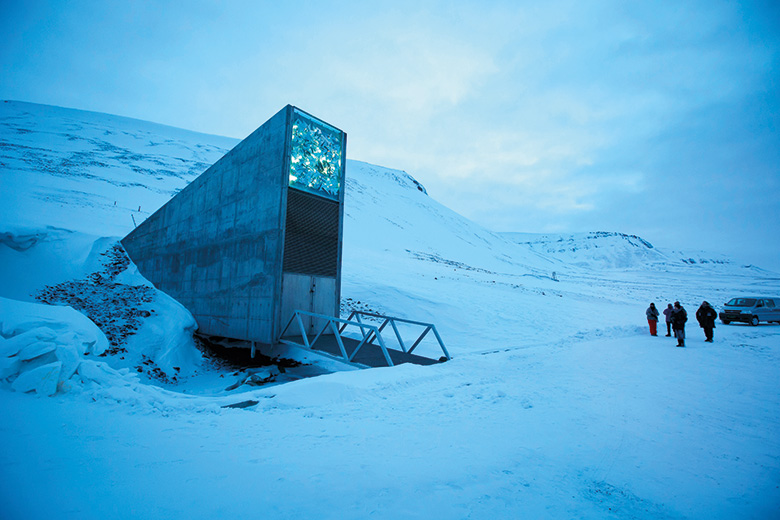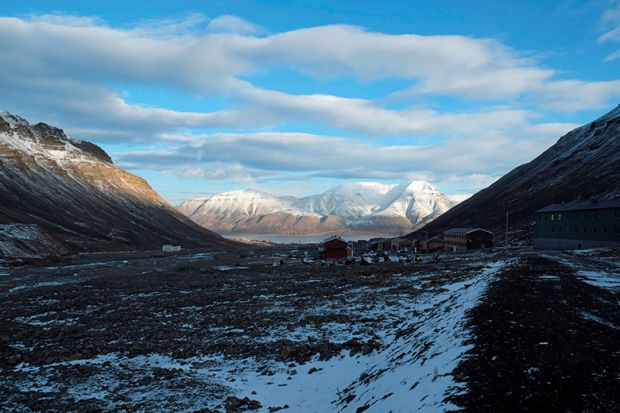It seems fair to call my trip to the polar region in January an expedition, even though I had excellent mobile phone reception, fast wi-fi and freshly baked croissants for breakfast at the hotel where the conference I was attending was held.
Longyearbyen, on Spitsbergen island in the Svalbard archipelago, is the world’s northernmost human settlement. And its isolation – a four-hour flight north from Oslo and a mere 1,000km from the North Pole – and extreme climate give rise to suitably quirky customs.
Perhaps foremost among these is the ban on dying there, on account of the fact that buried bodies don’t decompose – and, indeed, are sometimes brought back to the surface by the permafrost’s natural heaving. Anyone who is gravely ill (or just old) is expected to relocate to a different part of Norway to expire.
That is somewhat ironic given the excess of natural hazards this far inside the Arctic Circle. For instance, people venturing beyond a secure zone in the middle of town must be armed in case of encounters with polar bears. This used to be rare within the settlement, but the alerts were plentiful during the week I was there. Global warming has apparently reduced the bears’ hunting grounds, altering their habitual ranging patterns.
Notwithstanding the considerable further evidence of global warming (recent avalanches, extreme weather swings, glacial melting that local residents can detect clearly from year to year), I was still confronted by the coldest weather I have ever experienced. In the midst of an impenetrable Arctic night, with sunrise still a month away, temperatures hovered around -12°C but felt even more biting when gale-force winds whipped sharp pins of ice into whatever small patches of our skin were not covered by layers of protective clothing.
As my fellow delegates and I traversed the tundra during one excursion, I feared I might literally be blown off the ice-encrusted earth by one of the ferocious gusts. And, at the risk of sounding melodramatic, there was one long walk in particular – 3.5km, according to a colleague’s Fitbit – during which I honestly wondered whether I would be able to survive. But, as there was nowhere to stop for rest or shelter, and no option other than to plod on, survive I did.
On another occasion, we went on a 10km dogsled trek across Arctic terrain that we could not even see beyond shadowy outlines of mountains and glaciers. (Later, a Google Images search for daylight pictures of the Foxfonna district revealed the stunning landscapes we had missed.) We also took long hikes to see the northernmost church and meet the northernmost pastor, after visiting the northernmost hoteliers, skin-traders and other entrepreneurs, learning about what it feels like to live in such a place, and how its residents think about their corner of the world in relation to the rest of us. I tagged a windblown picture of myself with frozen eyelashes: “Northernmost English professor”.
Far beyond my usual comfort zone, this adventure was made at least a little more familiar by the conference that was the official reason for my presence. Designed to leverage the extreme setting, it was called “Rethinking remoteness and peripherality”. As interesting as the programme was – lectures about the latest frontiers of exploration, globalism and technology, not to mention ghosts on remote Danish islands and sheep on remote Estonian islands – I wouldn’t have gone if it had taken place in, say, Nebraska. The real draw, for me, had been those few days spent chilling, so to speak, before the formal symposium began with co-convener Adam Grydehøj, director of Copenhagen’s Island Dynamics research organisation.
What a brilliant conference experience was created by this merging of ideas with place, theory with practice, academia with hard, cold reality. “If we are talking about the remote,” the other convenor, Yaso Nadarajah, senior lecturer in international development at the Royal Melbourne Institute of Technology, told the conference, “I want to talk about it in the remotest town in the world.”
The constant darkness made the meeting seem at times like a slumber party. Without daylight, most people never fully recovered from their jet lag, which made for somewhat groggy discussions. But the exchanges were also zestfully earnest: a pleasant change from more reserved standards of academic propriety.
Remoteness, explained Robin Zebrowski, associate professor of cognitive science at Wisconsin’s Beloit College, does not inherently mean far away – it’s just where you are not. Telecommuting is a remote phenomenon, as is telesurgery (in which doctors operate on someone robotically from another room or another country) – not to mention teledildonics (tactile erotic communication via data link).

Conference delegates grappled with “the Idea of North” (the title of a 2005 book by University of Oxford professor Peter Davidson) and its relation to other directions. “North is meteorologically adverse, isolated, difficult to reach,” observed Cathy Lane, professor of sound arts at the University of the Arts London, who studies and creates northern soundscapes: “a sonic iconography of remoteness”. But the remote north is an elusive concept, she added, because, unless you are standing at the North Pole, you can always go further north: “ north” is “north of you”. While “south” is “pleasure, plenty”, “north” embodies “a huge vastness which diminishes you: an idea of an ambiguous paradise where nature exists as if in a vacuum, in a state of pre-industrial purity”.
“Go north!” is Scandinavia’s version of the American pioneers’ cry of “Go west!”, according to Owe Ronström, professor of cultural anthropology and ethnology at Uppsala University in Sweden. Ronström, who works at Uppsala’s campus on the remote Swedish island of Gotland, where he was born, added that “remoteness is produced rather than discovered, through a perspective, a gaze, an affective mode”. Water is especially effective at creating remoteness, but forests, mountains or vast plains will also work. But remoteness is also a volatile quality, he suggested; if one stays too long in the remote it becomes comfortable.
It should not shock any academic to learn that the more we anatomised the tropes and discourses on remoteness and northernness, the less clear it became what these concepts mean. From what, precisely, were we remote? Who is central, who is marginalised and who decides? “North” is north of what? (Scholars of the global South ask the same kinds of questions, upside down.)
Sociologist Immanuel Wallerstein’s world systems theory resonates here: the political binary of core versus peripheral power relations creates hierarchies that benefit some cultures and exploit others. The history of imperialism situates a capital as a centralised seat of power, construing “remote” lands as places to be toured, plundered, conquered and fetishised.
A thousand years ago, the German chronicler Adam of Bremen wrote: “Beyond Norway, which is the farthermost northern country, you will find no human habitation, nothing but ocean, terrible to look upon and limitless, encircling the whole world.” Contemporary renderings are a bit less fraught – though, in his Letters from Iceland, W. H. Auden notes that, although he was enchanted by the sub-Arctic region, most people were still deterred: “North means to all: reject!” The American writer Rebecca Solnit, describing a sea voyage to Svalbard in her 2015 book The Encyclopedia of Trouble and Spaciousness, found that the place “imposed a dependency...which was also an independency, from the rest of the world”.
Remote islands “become footnotes to the mainland,” the German writer Judith Schalansky writes in her 2009 book The Atlas of Remote Islands , “expendable to an extent, but also disproportionally more interesting”. And Uppsala’s Ronström noted that islanders, like interlopers, often appraise their status with uncertainty, internalising their remoteness with a feeling of pride but an accompanying sense of inferiority, reflecting an anxiety that things from outside may be more refined. (The Oxford English Dictionary bears that sense out to some extent, defining “remote” as “cut-off from the features of civilisation”.)
Svalbard – which means “Cold Edge”: the most perfectly fitting place name I have ever encountered – seemed remote to we conference delegates because we all lived so far away. Some of us had taken six plane connections to get there; others, waylaid by weather, missed the first few days. Grydehøj’s suitcase spent the first half of the week in the Canary Islands, enjoying a much more temperate strain of remoteness, before completing a comically difficult passage to the Arctic.
But Svalbard is home for its 2,000 surprisingly cosmopolitan residents, hailing from 51 different nations (15 of which, admittedly, have only a single representative). Many come for short-term, high-paying jobs and move on after a year or two, but some we met have stayed for 20 years. Residents still feel remote in some ways, they told us, because they are compelled to travel back to the mainland (or much further for the island’s sizeable Thai contingent, for instance) to see their families or to be treated for medical conditions beyond the expertise of the small local sykehus (infirmary). But they have also found ways of sustaining a long-term community.
Norwegian Christmas dinners, for example – which are normally insular family events – become neighbourhood feasts in Longyearbyen. And we met some older people who have at least considered trying to live out their final days here – which would involve arranging private medical support and care. (And while burial is impossible, a petition to the local church pleading “special circumstances” can sometimes yield permission for the interment of cremated ashes, the pastor told us.)
Svalbard is also central to civilisation in one key respect. Its Global Seed Vault is a backup storage facility for plant life: “the ultimate insurance policy”, as they describe it. Tunnels burrowed deep into a frozen mountain protect seeds that will allow the reintroduction of agriculture in the event of an apocalypse. Nearly a million seeds from almost every country have been deposited there (and may be withdrawn only by the country that contributed them), and the archive is still expanding, with a capacity for more than four times its present contents. Sadly, it is closed to the public for reasons of security and contamination – but I did catch an exciting glimpse of the distinctive greenish light sculpture above its entrance as I flew out.
Global warming, too, makes Svalbard less remote than it once was, as shipping routes and other commercial activities are reconfigured as the polar ice recedes. Many conference delegates felt that going there was an important act of bearing witness to climate crisis, and we vowed to bring back first-hand stories of our personal experiences of the endangered icescape. At the same time, we were not oblivious to the significant carbon footprint that we had left in getting there (never mind the one left by the croissants). But we are not the only culprits in that regard. Burgeoning tourism initiatives attract a diversity of visitors from all over the world to experience Svalbard’s remoteness – an enterprise that is surely self-defeating at scale.
Remoteness becomes more appealing and necessary, but also more elusive, as the world becomes an indelibly wired global village, where everyone speaks English and few places remain to which you can retreat to think – or do whatever else it is you are supposed to do far from the madding crowd. “I’ve visited remote places,” reflects travel writer Pico Iyer, “partly as a way to visit remote states of mind: remote parts of myself that I wouldn’t ordinarily explore.” At the conference, Lane expressed a similar sentiment, and one that I shared as well: “Being here has made me feel so internal,” she said, exuberantly.
Ascending out of Svalbard on my flight home, the first natural light I had seen in a week – a faint red-orange glow on the horizon – shocked me with its power. The much-welcomed sunrise underlined what I had been deprived of while exploring the world’s remotest territory and my own personal sense of remoteness. This adventure of a lifetime had been intensely sensory and philosophical, making me feel more vulnerable than I would previously have imagined possible, but also more resilient. And so it was with a mixture of sadness and relief that I left behind a darkness more profound than anything I will probably ever encounter again.
Randy Malamud is Regents’ professor of English at Georgia State University. He is the author of The Importance of Elsewhere: The Globalist Humanist Tourist, forthcoming from Intellect.
POSTSCRIPT:
Print headline: Remote possibilities
Register to continue
Why register?
- Registration is free and only takes a moment
- Once registered, you can read 3 articles a month
- Sign up for our newsletter
Subscribe
Or subscribe for unlimited access to:
- Unlimited access to news, views, insights & reviews
- Digital editions
- Digital access to THE’s university and college rankings analysis
Already registered or a current subscriber?




